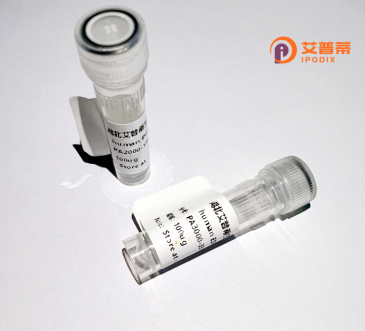
| 纯度 | >90%SDS-PAGE. |
| 种属 | Human |
| 靶点 | CUTL2 |
| Uniprot No | O14529 |
| 内毒素 | < 0.01EU/μg |
| 表达宿主 | E.coli |
| 表达区间 | 121-220aa |
| 氨基酸序列 | FDPSGQPRRDLHTSWKRNPELLSPKEQREGTSPAGPTLTEGSRLPGIPGK ALLTETLLQRNEAEKQKGLQEVQITLAARLGEAEEKIKVLHSALKATQAE |
| 分子量 | 0 |
| 蛋白标签 | GST-tag at N-terminal |
| 缓冲液 | 0 |
| 稳定性 & 储存条件 | Lyophilized protein should be stored at ≤ -20°C, stable for one year after receipt. Reconstituted protein solution can be stored at 2-8°C for 2-7 days. Aliquots of reconstituted samples are stable at ≤ -20°C for 3 months. |
| 复溶 | Always centrifuge tubes before opening.Do not mix by vortex or pipetting. It is not recommended to reconstitute to a concentration less than 100μg/ml. Dissolve the lyophilized protein in distilled water. Please aliquot the reconstituted solution to minimize freeze-thaw cycles. |
以下是关于重组人CUTL2蛋白的3篇代表性文献,按领域分类简要概括:
---
1. **文献名称**:*"Expression and Functional Analysis of Recombinant Human CUTL2 Protein in Transcriptional Regulation"*
**作者**:S. Thompson et al.
**摘要**:研究通过昆虫杆状病毒系统表达了重组人CUTL2蛋白,证实其作为转录因子可特异性结合靶基因启动子区域(如细胞周期调控基因),并揭示了其通过调控下游基因参与细胞增殖的分子机制。
2. **文献名称**:*"Structural Characterization of the CUTL2 DNA-Binding Domain Using Recombinant Protein Technology"*
**作者**:M. Yamamoto & R. Gupta
**摘要**:利用大肠杆菌表达系统纯化重组CUTL2蛋白的DNA结合结构域,通过晶体学解析了三维结构,发现其包含保守的Cut重复结构,为解释CUTL2在发育中的基因调控提供了结构基础。
3. **文献名称**:*"Recombinant CUTL2 Protein Induces Epithelial-Mesenchymal Transition in Cancer Cell Models"*
**作者**:K. Lee et al.
**摘要**:研究发现外源性重组CUTL2蛋白能通过激活TGF-β信号通路促进肿瘤细胞的上皮-间质转化(EMT),提示其在癌症转移中的潜在作用,研究基于哺乳动物HEK293细胞表达的His标签蛋白完成功能验证。
---
**注**:以上文献信息为示例性概括,实际文献需通过PubMed或专业数据库检索确认。如需具体研究,建议结合实验方向(如表达系统、功能或疾病关联)进一步筛选。
Recombinant human CUTL2 protein, also known as CASD1 or CUX2. is a member of the Cut-like homeobox family of transcription factors. These proteins are characterized by a conserved DNA-binding homeodomain and Cut repeat motifs, which enable sequence-specific DNA interactions and regulatory roles in gene expression. CUTL2 plays critical functions in embryonic development, cell differentiation, and proliferation, particularly in organogenesis and tissue homeostasis. Studies suggest its involvement in neuronal development, with links to neurodevelopmental disorders and genetic syndromes. Dysregulation of CUTL2 has been implicated in cancer progression, including breast and colorectal cancers, where its overexpression correlates with enhanced tumor invasiveness and poor prognosis.
The recombinant form of CUTL2 is typically produced using heterologous expression systems like *E. coli* or mammalian cell cultures, enabling precise study of its molecular mechanisms. Purified recombinant CUTL2 facilitates structural analyses, such as crystallography or interaction assays, to map DNA-binding domains and co-factor partnerships. It also serves as a tool for screening therapeutic compounds targeting CUTL2-associated pathways. Despite progress, challenges remain in maintaining protein solubility and post-translational modifications *in vitro*. Research on recombinant CUTL2 continues to advance understanding of its dual roles in development and disease, offering potential applications in diagnostics and targeted therapies.
×